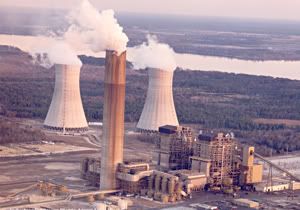Energy Watch: Ruling could disrupt plans for new coal plants nationwide
 Clean energy advocates are celebrating yesterday's decision by an Environmental Protection Agency appeals board requiring the consideration of greenhouse gas emissions in the licensing of a new coal-fired power plant in Utah.
Clean energy advocates are celebrating yesterday's decision by an Environmental Protection Agency appeals board requiring the consideration of greenhouse gas emissions in the licensing of a new coal-fired power plant in Utah.The Environmental Appeals Board ruling [pdf] held that EPA had no valid reason for refusing to limit carbon dioxide pollution from new coal plants. The decision came in a lawsuit brought by the Sierra Club, which says the ruling means all new and proposed coal plants nationwide must take action to control their carbon emissions.
"Today's decision opens the way for meaningful action to fight global warming and is a major step in bringing about a clean energy economy," says Joanne Spalding, the Sierra Club attorney who argued the case. "This is one more sign that we must begin repowering, refueling and rebuilding America."
Bruce Nilles, director of Sierra's National Coal Campaign, says he expects the decision will send all pending permits back to the applicant to include carbon dioxide limits, a process that could take anywhere from six to 12 months. In the meantime, he and other clean energy advocates say they will press the new administration to set carbon emission limits that will essentially make it impossible to build conventional polluting coal plants.
In its own analysis, Akin Gump -- an international law firm with a large energy practice -- noted that the ruling effectively places the decision on the extent to which EPA will regulate CO2 under the Clean Air Act "squarely in the lap of the Obama Administration." Obama has been an outspoken supporter of so-called "clean coal" technologies that aim to capture and store carbon dioxide from coal-fired power plants.
Yesterday's ruling follows a 2007 U.S. Supreme Court decision that recognized carbon dioxide as a pollutant under the federal Clean Air Act. Earlier this year, the Sierra Club asked EAB to overturn the EPA Region 8-issued air permit for Deseret Power Electric Cooperative's proposed waste coal-fired power plant in Utah's Uintah County because it didn't require controls on carbon dioxide. In this case, the air permit is handled by federal rather than state officials because the plant is located on Ute tribal land.
As it's currently designed, the new 110-megawatt facility planned for the existing Bonanza plant would emit more than 3 million tons of carbon dioxide each year.
There are currently 65 locations around the country where plans are actively underway to build new coal plants, according to a Sierra Club database. Of those, 22 are in the South: four each in Kentucky and Texas, three in Louisiana, two each in Arkansas, Georgia and West Virginia; and one each in Florida, Mississippi, North Carolina, South Carolina and Virginia.
(Photo of Florida's Seminole coal-fired power plant from Seminole Electric Cooperative.)
Tags
Sue Sturgis
Sue is the former editorial director of Facing South and the Institute for Southern Studies.
